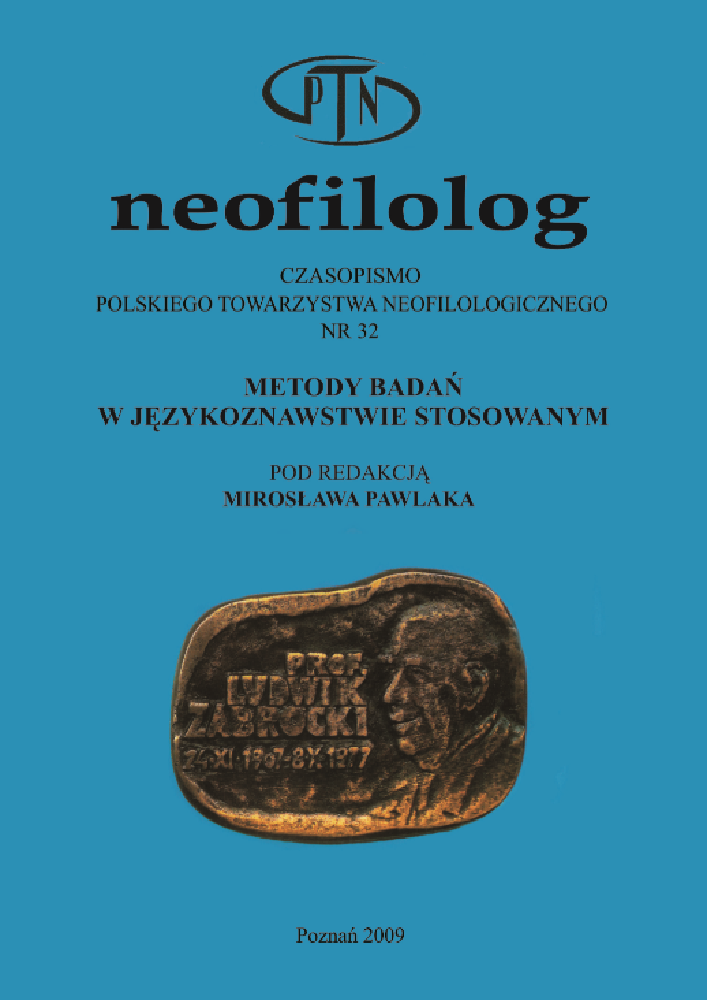Abstract
This paper outlines relevant issues in analyzing foreign language classroom communication patterns. Following a brief theoretical and historical background, it proceeds to discuss technical aspects of data collection and elaboration. Recording interaction between teachers and students is difficult but it later leads to an even more challenging task of transcribing talk. For this purpose, the article offers model instances of different traditions in compiling transcripts. However, the bulk of the present text is devoted to the exemplification of different applications of analysis of educational discourse. The samples, drawn from classroom interactions involving English, French and Polish as L2, illustrate topics such as corrective feedback, metatalk, the use of L1, and teacher questions. At the end, recommendations are given regarding further explorations and readings.
References
Basturkmen, H. 2001. „Descriptions of spoken language for higher level learners: The example of questioning”. ELT Journal 55. 4-13.
Bellack, A. A., Kliebard, H. M., Hyman, R. T. i Smith Jr., F. L. 1966. The language of the classroom. Final report, USOE Cooperative Research Project, No.
New York: Teachers College Press, Columbia University.
Bernstein, B. 1990. Class, codes and control, Vol. 4: The structure of pedagogic discourse. London: Routledge.
Brown, J. D. i Rodgers, T. S. 2002. Doing second language research. Oxford: Oxford University Press.
Candlin, C. C. i Mercer, N. (red.). 2001. English language teaching in its social context. A reader. London: Routledge.
Cazden, C. B. 1988. Classroom discourse. The language of teaching and learning. Portsmouth, NH: Heinemann.
Freeman, D. 1998. Doing teacher research: From inquiry to understanding. Pacific Grove: Heinle & Heinle Publishers.
Guan Eng Ho, D. 2005. „Why do teachers ask the questions they ask?”. RELC Journal 36. 297-310.
Labov, W. 1970. Sociolinguistic patterns. Oxford: Basil Blackwell.
Long, M. H. i Sato, C. J. 1983. „Classroom foreigner talk discourse: Forms and functions of teachers’ questions”, w: Seliger, H. W. i Long, M. H. (red.). 1983. 268-285.
Lyster, R. i Ranta, L. 1997. „Corrective feedback and learner uptake”. Studies in Second Language Acquisition 19. 37-66.
Łęska, K. 2007. „‘Metamowa’ na lekcjach języka angielskiego”, w: Majer, J. i Nijakowska, J. (red.). 2007. 109-127.
Łęska, K. 2008. Teachers’ use of interaction patterns in a foreign language classroom and gains in students’ oral fluency. Częstochowa: Wydawnictwo Wyższej Szkoły Lingwistycznej.
Majer, J. 2003. Interactive discourse in the foreign language classroom. Łódź: Wydawnictwo Uniwersytetu Łódzkiego.
Majer, J. 2008. „Negotiation of form in foreign-language classroom discourse”, w: Pawlak, M. (red.). 2008. 79-94.
Majer, J. i Nijakowska, J. (red.). 2007. Język – Poznanie – Zachowanie. Studia nad psycholingwistycznymi aspektami przyswajania języka. Łódź: Wydawnictwo Uniwersytetu Łódzkiego.
Mehan, H. 1979. „‘What time is it, Denise?’. Asking known information questions in classroom discourse”. Theory into Practice 18. 285-294.
Niżegorodcew, A. 2007. Input for L2 learners. The relevance of relevance. Clevedon: Multilingual Matters.
Nunn, R. 1999. „The purpose of language teachers’ questions”. IRAL 37. 23-42.
Pawlak, M. 2004. Describing and researching interactive processes in the foreign language classroom. Konin: Wydawnictwo Państwowej Wyższej Szkoły Zawodowej w Koninie.
Pawlak, M. (red.). 2008. Investigating English language learning and teaching. Poznań – Kalisz: Wydawnictwo Wydziału Pedagogiczno-Artystycznego UAM w Kaliszu.
Pica, T. 1996. „Do second language learners need negotiation?”. IRAL 34. 1-21.
Piotrowski, S. 2006. Gestion des tâches et mode d’accés à la langue. Lublin: Towarzystwo Naukowe KUL.
Riggenbach, H. 1999. Discourse analysis in the language classroom. Volume 1. The spoken language. Ann Arbor: The University of Michigan Press.
Rowe, M. B. 1987. „Using wait time to stimulate inquiry”, w: Wilen, W. W. (red.). 1987. 102-109.
Sarangi, S. i van Leeuwen, T. (red.). 2003. Applied linguistics and communities of practice. London: Continuum.
Seedhouse, P. 2004. „The interactional architecture of the language classroom: A Conversation Analysis perspective”. Language Learning Monograph Series 4. 1-272.
Seliger, H. W. i Long, M. H. (red.). 1983. Classroom-oriented research in language learning. Rowley, MA: Newbury House.
Sinclair, J. i Brazil, D. 1982. Teacher talk. Oxford: Oxford University Press.
Sinclair, J. i Coulthard, M. 1975. Towards an analysis of discourse: The English used by teachers and pupils. London: Oxford University Press.
Spada, N. i Lightbown, P. M. 1993. „Instruction and the development of questions in L2 classrooms”. Studies in Second Language Acquisition 15. 205-224.
Swann, J. 2001. „Recording and transcribing talk in educational settings”, w: Candlin, C. C. i Mercer, N. (red.). 2001. 323-344.
van Dijk, T. 2001. Dyskurs jako struktura i proces. Warszawa: Wydawnictwo Naukowe PWN.
van Lier, L. 1984. „Analysing interaction in second language classrooms”. ELT Journal 38. 160-169.
Wilen, W. W. (red.). 1987. Questions, questioning techniques, and effective teaching. West Haven, CT: NEA Professional Library.
Wragg, E. C. 2001. Co i jak obserwować w klasie? Warszawa: Wydawnictwo Akademickie „Żak”.
License
Copyright (c) 1970 Jan Majer

This work is licensed under a Creative Commons Attribution-NoDerivatives 4.0 International License.
Authors
Authors of texts accepted for publication in Neofilolog are required to complete, sign and return to the Editorial team’s office the Agreement for granting a royalty-free license to works with a commitment to grant a CC sub-license.
Under the agreement, the authors of the texts published in Neofilolog grant Adam Mickiewicz University in Poznań a non-exclusive, royalty-free license and authorize the use of Attribution-NoDerivatives 4.0 International (CC BY-ND 4.0) Creative Commons sub-license.
The authors retain the right to the free disposal of the work.
Users
Interested Internet users are entitled to use works that have been published in Neofilolog since 2017, under the following conditions:
▪ attribution – obligation to provide, together with the distributed work, information about the authorship, title, source (link to the original work, DOI) and the license itself.
▪ no derivatives – the work must be preserved in its original form. Without the author's consent, it is not possible to distribute the modified work in the form of translations, publications, etc.
Copyrights are reserved for all texts published since 2017.
Miscellaneous
Adam Mickiewicz University in Poznań retains the property right as a whole (layout, graphic form, title, cover design, logo etc.).
